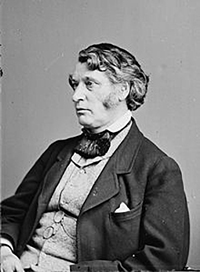Precedents for Chaos and Tyranny - Part 2 of 3

The January 6 Committee intends to use the 14th Amendment to block former President Trump from running again in 2024.
The Fourteenth Amendment consists of five sections. The first clause of Section 1 defines who is a citizen:
“All persons born or naturalized in the United States and subject to the jurisdiction thereof, are citizens of the United States and of the State wherein they reside.”
This overturned the Dred Scott Supreme Court decision of 1857, which based on previous precedents, denied citizenship to blacks.
A liberal interpretation of this clause, not intended by its writers but never challenged in the Supreme Court, later resulted in huge ongoing immigration problems. According to a 2018 Center for Immigration Studies (CIS) paper, at least 290,000 children per year born in the U.S. to illegal immigrants are counted as citizens. The birth costs alone cost U.S. taxpayers $2.4 billion per year. The total cost every year is $5.3 billion. There are approximately 4.5 million children of illegal immigrants in the United States under age 18. This lenience has also led to “birth-tourism.” A 2020 report by Tucker Carlson estimated the total annual impact of birthright citizenship and birth-tourists had grown to 400,000 annually. Only President Trump has considered correcting this by executive order to bring it before the Supreme Court.
The second clause of Section 1 prevented states from abridging the rights of citizens and denying any person due process and equal protection of the laws.
“No State shall make or enforce any law which shall abridge the privileges or immunities of citizens of the United States.”
One reason for this section was to prevent Southern states from implementing “Black Codes” limiting the rights of former slaves. Some Mississippi legislation in particular was raising concern that the emancipation of slaves by the 13th Amendment was being circumvented.
At this very time, however, many Northern states had Black Codes more severe than any emerging in the South. Indiana law codes would not allow blacks and mulattos to come into the state. Illinois, the land of Lincoln, and Oregon were almost as restrictive of black immigration. Numerous other Northern states including Kansas, Michigan, Connecticut, Minnesota, and Wisconsin had rejected Negro suffrage and with it other rights and privileges of full citizenship.
The third clause, “nor shall any State deprive any person of life, liberty or property, without due process of law,” expanded the due process clause of the Fifth Amendment to apply to the states as well as the federal government.
Section 2 eliminated the three-fifths rule for slaves in apportioning legislative representation. Each person was to be counted as a whole person. This section allowed for reducing representation as a penalty for its violation and left the door open to abridging the rights of those who had participated in “rebellion.” Section 3 was the most objectionable to the South. It denied public office to any person who had supported the Confederacy during the war. This essentially limited civic leadership at any level to the planned constituents of the Radical Republicans. It was not only humiliating and debilitating to the South but designed to guarantee Republican political hegemony in the South without significant opposition. Section 4 repudiated all Confederate debt and legitimized the obligation of all citizens to pay for U. S. debt incurred during and after the war. Section 5 gave Congress the power to enforce the other four sections by legislation. This was thought by many to be an open door to increasing federal power over the states, which turned out to be quite true.
The 39th Congress convened in December of 1865 just as the states, including seven Southern states, were finalizing ratification of the 13th Amendment abolishing slavery. The Radical Republicans, however, knew that they could not depend on elected Southern Congressmen to achieve the two-thirds super majorities in the U. S. Senate and House needed to pass the 14th amendment. Consequently, they mustered a majority in both Houses of Congress and voted not to seat the 22 Senators and 58 representatives from eleven formerly Confederate, Southern states. This was accomplished in part by “waving the bloody shirt” of Union losses during the war, impugning the patriotism of those willing to welcome the Southern states back into the Union fold, and appealing to partisan greed and lust for power.
Moreover, in the U. S. Senate they could count only 33 of 50 votes, just one short, of that necessary for the two-thirds majority to pass a Constitutional Amendment. To overcome this they devised a plan to retroactively unseat John P. Stockton of New Jersey, an outspoken opponent of the 14th Amendment. It would have required a two-thirds vote to expel Senator Stockton for cause, but they could not muster the votes. After several days of high pressure political maneuvering using the usual accusations and unseemly tactics, the Radical Republicans were able on March 27 to retroactively unseat Stockton. The excuse was that the New Jersey Legislature had elected him by a plurality rather than a majority vote, but this was legal in New Jersey as well as several other states. In those days, U.S. Senators were elected by state legislatures rather than popular vote. Such a retroactive unseating for transparently political objectives was highly irregular, but the 14th Amendment was counted as having passed the Senate on June 13, 1866. A few days earlier the Amendment had passed the U. S. House with 120 votes, easily more than two-thirds of the 152 that voted, but there were 30 abstentions.
The Amendment was then required to go to President Johnson before going to the States for approval. Johnson, a strict Constitutionalist and opponent of the Amendment, was somehow bypassed. The Amendment then went to the 37 States. A Constitutional amendment requires ratification by three-quarters of the States, or in this case 28. A rejection or failure to ratify by ten states would have killed the amendment.
Tennessee was the first to ratify the amendment, but without a proper quorum of its legislature. Nevertheless, despite this irregularity, Tennessee was counted for ratification. By February 6, 1867, all ten of the remaining Southern states and three border states had rejected the amendment. California refused to consider it and later rejected it. In addition, Ohio in January of 1868, and New Jersey in March of 1868, reacting to Radical Republican despotism and public displeasure thereof, rescinded their earlier ratifications. Oregon had ratified in September of 1866, but after settling a controversy over a few legislative seats, formerly rescinded on October 15, 1868. The Oregon rescission was too late, however, to affect the eventual outcome.
The Radical Republicans, moreover, had a radical plan to reverse Southern rejections of the 14th Amendment that fit their longer range agenda very well. Under their leadership on March 2, 1867, a Reconstruction Act was passed over the veto of President Johnson that revoked the legal status of the ten Southern states that had rejected the 14th Amendment and placed them under a military government administered through five U. S. Army districts.
The inconsistency, appalling capriciousness, and hypocrisy of the Radical Republican position should be noted here. If the Southern States were legal enough to have just ratified the 13th Amendment, how could Thaddeus Stevens now say that these same states were “without any legal authority?” It demonstrated once again the arbitrary and tyrannical mindset of the Radical Republicans. This would become increasingly evident during the years of Reconstruction. It was also certainly evident in their contrived attempt to impeach President Andrew Johnson for trying to dismiss his Secretary of War, Edwin Stanton. But as previously indicated, the Radical Republicans had little regard for the Constitution, legal precedent, any concept of fairness, or honest parliamentary procedure.
And what of the declared Union objectives of the War? Reunification of the states now became secondary to the vengeful and totalitarian will of a few men who proclaimed themselves to be the will of the people. The Radical Republican vision for the South can be clearly seen here. In effect, after a long and bloody war “to hold the Union together,” Radical Republicans now kicked the South out of the Union for their own selfish, political purposes. Southern states were to be subjugated tools of Radical Republican ambitions. Every vestige of their culture, heritage, and political sovereignty would be subjected to a campaign of deliberate debasement and attempted eradication. It revealed that a strong underlying Northern motivation for the War was keeping the South under their economic and political control as subjugated territories stripped of their political rights. The purpose of the Reconstruction was to further subjugate and exploit the South, and this was done with a spirit of malice. Re-admission depended upon their declared acceptance of the 14th Amendment.
One of the objectives of the Reconstruction Act was to enfranchise black males and disenfranchise enough Confederate veterans and former Confederate officials to ensure Republican victories. According to author Phil Leigh, at least 228,000 Confederate veterans were disenfranchised. Perhaps more were intimidated from voting. This was carpetbag rule of the South, referred to as the years of “Negro Supremacy” in some states. In order to assure political dominance, the Radical Republicans used “Union League” catechisms to indoctrinate former slaves with resentment and hatred for their former masters. Other sections of the act were designed to subdue Southern spirit and provide for continued economic exploitation of the South. This was part of a plan to establish a permanent Radical Republican dominance in the South and thereby the nation. The war had been ruinous, but military and “carpetbagger” governments would see to it that the ruin was increased and recovery was slow. Reconstruction was to be continued war by ruthless and unsavory political means.
Kentucky was not a seceded state, and 110,000 Kentuckians served in the Union Army, but 35,000 Kentuckians served in the Confederate Army. Kentucky not only rejected the 14th Amendment in January 1867, but by overwhelming majorities in a May 1867 election, sent a solid slate of nine Democrats to Congress. On July 3, the Radical Republican Congress voted not to seat them. On July 5, Senator Sumner of Massachusetts threatened to place Kentucky and Maryland under military government. No action was taken on this, however, as Republicans began losing off year elections to Democrats in Northern states.
It was now demanded of the ten Southern States under military government that statehood would not be regained unless they ratified the 14th Amendment. Six Southern states complied with the reconstructive coercion, and with the ratifications of South Carolina and Louisiana on July 9, 1868, Congress declared the 14th Amendment ratified, ignoring the rescissions of Ohio, and New Jersey, and the impending rescission of Oregon. By law, however, the official recognition of ratification of a Constitutional amendment, rested with the Secretary of State, William H. Seward. Seward proclaimed ratification of the 14th Amendment on July 20, but in his written and oral proclamation he referred to the questionable status of the Ohio and New Jersey ratifications in view of their later rescissions. Congress was unhappy with this. The next day, assuming the function of the Secretary of State, Congress proclaimed by joint resolution that the 14th Amendment was officially ratified. On July 28, Seward bowed to the Congressional resolution of the 21st and proclaimed the Amendment ratified. With all the irregularities, frauds, and coercions involved, however, what fair minded person would recognize the 14th Amendment as Constitutional? Yet it is accepted as such, and there are now many precedents in law based on the 14th Amendment.
It is an irony of history that the Democrats of 2009 to 2022 have become the Radical Republicans of 1865 to 1877. This is especially exemplified by the ruthless, dishonest, and unconstitutional tactics of the January 6 Committee’s Soviet-style show trial supported by a shamefully compliant “progressive” media.









 Mike Scruggs is the author of two books: The Un-Civil War: Shattering the Historical Myths; and Lessons from the Vietnam War: Truths the Media Never Told You, and over 600 articles on military history, national security, intelligent design, genealogical genetics, immigration, current political affairs, Islam, and the Middle East.
Mike Scruggs is the author of two books: The Un-Civil War: Shattering the Historical Myths; and Lessons from the Vietnam War: Truths the Media Never Told You, and over 600 articles on military history, national security, intelligent design, genealogical genetics, immigration, current political affairs, Islam, and the Middle East. 


